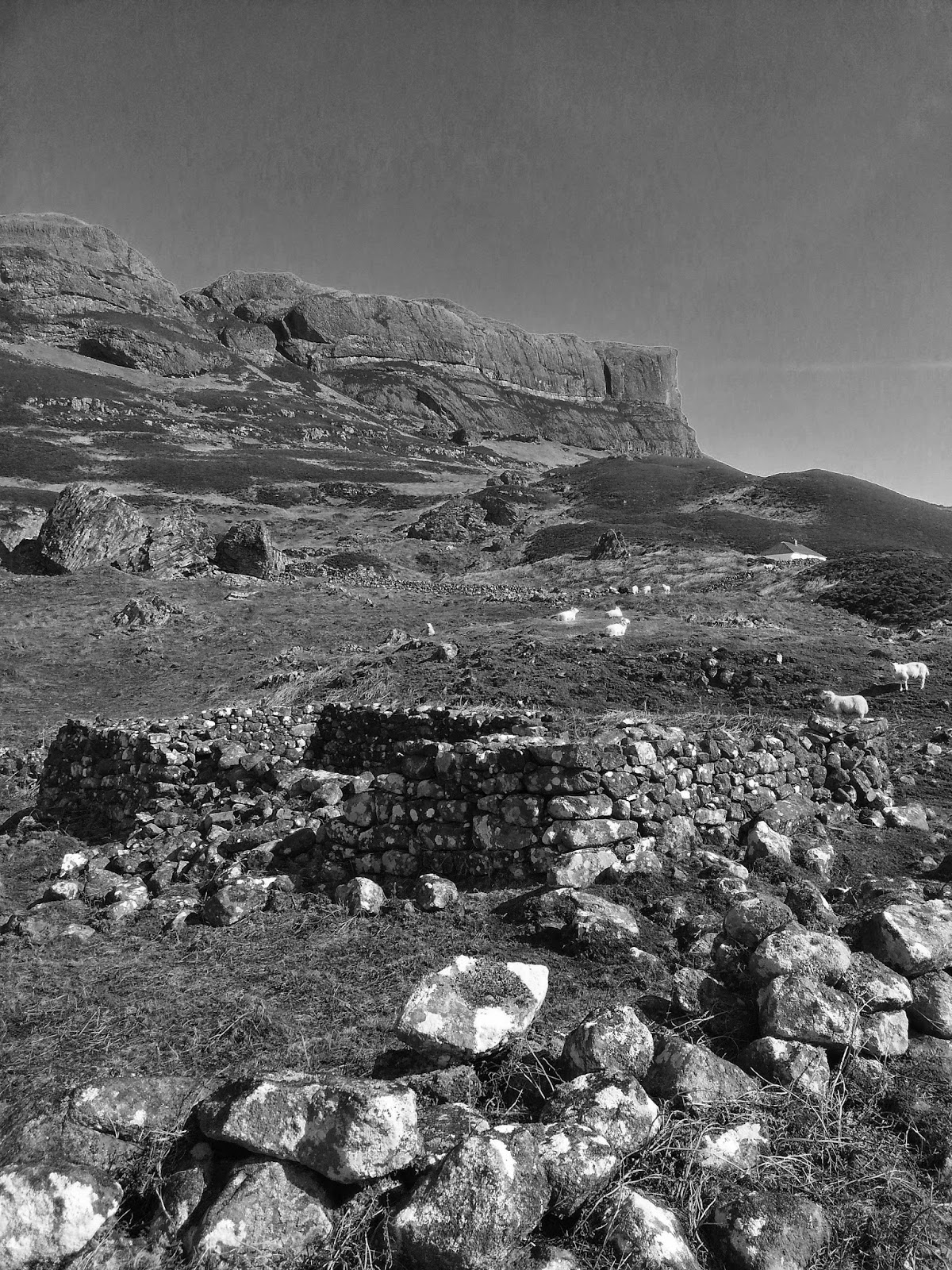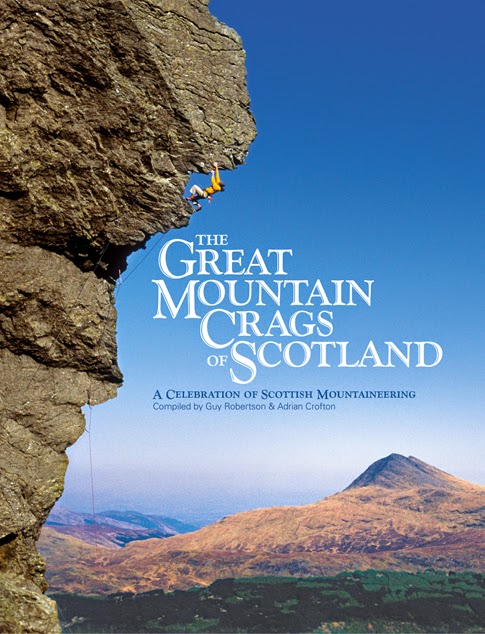Engram 1
I have touched a lot of rock in the last couple of decades and wanted to try and retrieve the emotions of it a little bit better, rather than just saying, oh yes, I've done that... and that...that too. If you took this attitude to climbing, there'd be no point moving at all, you'd have just gone through physical motions like going to work and it would all have no context at all. A climbing friend once said he felt strange that he might just be remembered for 'being able to hang on small bits of rock for ages" and this is the fear we have, that it is all meaningless.
I don't believe it is - most of us understand our climbing intuitively and it is a spiritual thing that just happens as you climb and is contiguous... no need to talk about it. I would feel the same, but also think it is worthwhile bringing something to the mountain or the stone other than just more desire... an echoing ear at least, or an engram eye. It is good when moving on new rock and old memories play out, or experience kicks in with some learnt trick of composure and technique... but the memories, which ones inform my climbing?
I came late to climbing, eventually finding a physical meaning in an environment I’d always known but never befriended. Rock was always part of my landscape on the coasts and hills of Ireland: tilting over rocky shores as a child like some dwarf drunk, daring each other up small basalt pinnacles and quarries, then later scaring myself witless on the chalk cliffs of County Antrim. I suppose that's where its meaning really worked its veins into me, like some ancient geological graft into my weak flesh and bird-thin bone.
We lived for a while on one of those porchlit houses perched on a basalt cliff, like something out of a Hitchcock movie. Lighthouses blinked in a glittering arc westwards from Ailsa Craig past Kintyre and Islay to Malin Head. I would sit with my father for hours on the concrete plinth above the porch, watching these flickering sequences until just occasionally they flashed all at once. Constellations jacked slowly through the night and the moon, a slow-motion lob of light, turned the chalk cliffs a deep and thoughtful blue.
During the long summers I would escape down secret fishermen paths on the chalk cliffs, exploring the echoing shoreline beneath the fulmar-ridden heights above me. I climbed over knee-prickly solution-pocketed limestone, rubbed my hand on the smoother sea-washed chalk in the great ears of sea caves, and sank into a dreamtime of stone. Climbing was then just a natural movement in my curious travels: traversing round tidal headlands, pulling up over sudden walls, grasping great clumps of grass and treacherous bluebell tongues as I climbed back up the steep vegetated cliffs...
The chalk cliffs are made of living things, long-dead and pasted together in a kind of communal freeze-frame of drift and chance. Belemnites, ammonites, billions of microscopic animules which under a microscope appear as some alien space opera; it was a stunning thought that these creatures had made a cliff-face out of something as simple as death. God did not echo here, something grander did...
I heard the first echoes of my own tiny human thoughts, I learnt consciousness and humility, I learned to understand rock could whisper the boggling random design of life - this was my church: an unmediated wonder, full of hidden jeweled anemones in the pocketed rock, scuttling life under seawet boulders, kittiwakes wheeling and and screeching along the guano-scented cliffs.
This was the 'John Muir' time for me when stone and nature grew irrevocably in me and I found I could not live without my window open and the sound of the sea slapping its belly against the cliffs all night.
I don't believe it is - most of us understand our climbing intuitively and it is a spiritual thing that just happens as you climb and is contiguous... no need to talk about it. I would feel the same, but also think it is worthwhile bringing something to the mountain or the stone other than just more desire... an echoing ear at least, or an engram eye. It is good when moving on new rock and old memories play out, or experience kicks in with some learnt trick of composure and technique... but the memories, which ones inform my climbing?
I came late to climbing, eventually finding a physical meaning in an environment I’d always known but never befriended. Rock was always part of my landscape on the coasts and hills of Ireland: tilting over rocky shores as a child like some dwarf drunk, daring each other up small basalt pinnacles and quarries, then later scaring myself witless on the chalk cliffs of County Antrim. I suppose that's where its meaning really worked its veins into me, like some ancient geological graft into my weak flesh and bird-thin bone.
We lived for a while on one of those porchlit houses perched on a basalt cliff, like something out of a Hitchcock movie. Lighthouses blinked in a glittering arc westwards from Ailsa Craig past Kintyre and Islay to Malin Head. I would sit with my father for hours on the concrete plinth above the porch, watching these flickering sequences until just occasionally they flashed all at once. Constellations jacked slowly through the night and the moon, a slow-motion lob of light, turned the chalk cliffs a deep and thoughtful blue.
During the long summers I would escape down secret fishermen paths on the chalk cliffs, exploring the echoing shoreline beneath the fulmar-ridden heights above me. I climbed over knee-prickly solution-pocketed limestone, rubbed my hand on the smoother sea-washed chalk in the great ears of sea caves, and sank into a dreamtime of stone. Climbing was then just a natural movement in my curious travels: traversing round tidal headlands, pulling up over sudden walls, grasping great clumps of grass and treacherous bluebell tongues as I climbed back up the steep vegetated cliffs...
The chalk cliffs are made of living things, long-dead and pasted together in a kind of communal freeze-frame of drift and chance. Belemnites, ammonites, billions of microscopic animules which under a microscope appear as some alien space opera; it was a stunning thought that these creatures had made a cliff-face out of something as simple as death. God did not echo here, something grander did...
I heard the first echoes of my own tiny human thoughts, I learnt consciousness and humility, I learned to understand rock could whisper the boggling random design of life - this was my church: an unmediated wonder, full of hidden jeweled anemones in the pocketed rock, scuttling life under seawet boulders, kittiwakes wheeling and and screeching along the guano-scented cliffs.
This was the 'John Muir' time for me when stone and nature grew irrevocably in me and I found I could not live without my window open and the sound of the sea slapping its belly against the cliffs all night.


